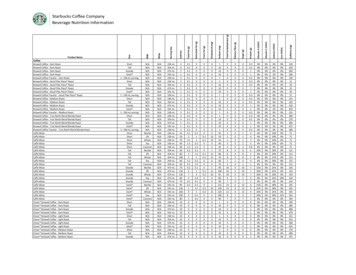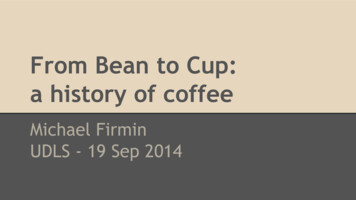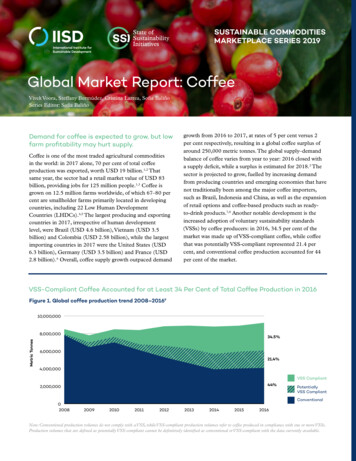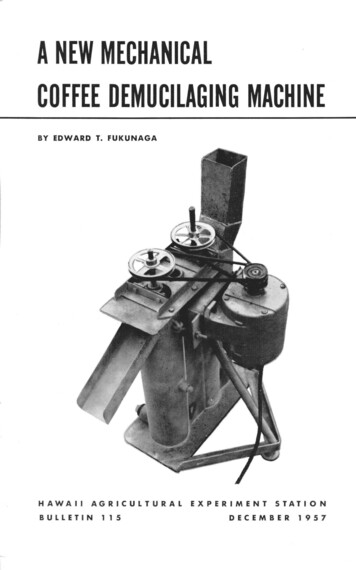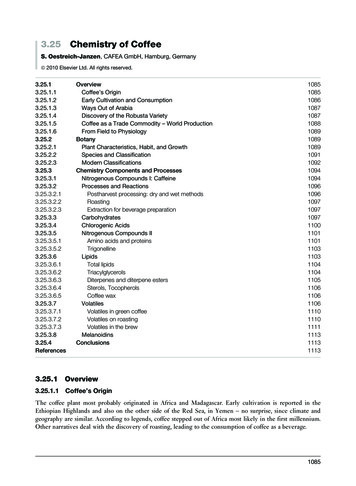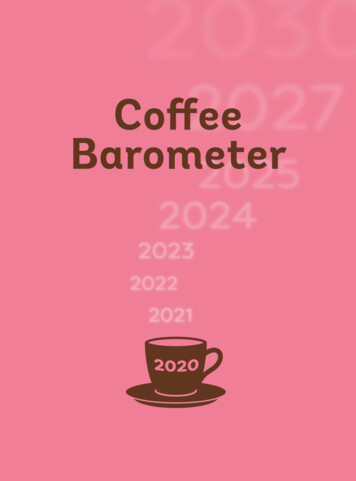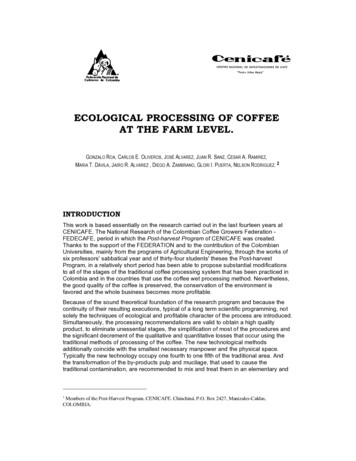
Transcription
ECOLOGICAL PROCESSING OF COFFEEAT THE FARM LEVEL.GONZALO ROA, CARLOS E. OLIVEROS, JOSÉ ALVAREZ, JUAN R. SANZ, CESAR A. RAMIREZ,MARIA T. DÁVILA, JAIRO R. ALVAREZ , DIEGO A. ZAMBRANO, GLORI I. PUERTA, NELSON RODRIGUEZ. 2INTRODUCTION,1This work is based essentially on the research carried out in the last fourteen years atCENICAFE, The National Research of the Colombian Coffee Growers Federation FEDECAFE, period in which the Post-harvest Program of CENICAFE was created.Thanks to the support of the FEDERATION and to the contribution of the ColombianUniversities, mainly from the programs of Agricultural Engineering, through the works ofsix professors' sabbatical year and of thirty-four students' theses the Post-harvestProgram, in a relatively short period has been able to propose substantial modificationsto all of the stages of the traditional coffee processing system that has been practiced inColombia and in the countries that use the coffee wet processing method. Nevertheless,the good quality of the coffee is preserved, the conservation of the environment isfavored and the whole business becomes more profitable.Because of the sound theoretical foundation of the research program and because thecontinuity of their resulting executions, typical of a long term scientific programming, notsolely the techniques of ecological and profitable character of the process are introduced.Simultaneously, the processing recommendations are valid to obtain a high qualityproduct, to eliminate unessential stages, the simplification of most of the procedures andthe significant decrement of the qualitative and quantitative losses that occur using thetraditional methods of processing of the coffee. The new technological methodsadditionally coincide with the smallest necessary manpower and the physical space.Typically the new technology occupy one fourth to one fifth of the traditional area. Andthe transformation of the by-products pulp and mucilage, that used to cause thetraditional contamination, are recommended to mix and treat them in an elementary and1Members of the Post-Harvest Program. CENICAFE. Chinchiná. P.O. Box 2427, Manizales-Caldas,COLOMBIA.
COFFEE PROCESSING AT THE FARM LEVEL,An Ecological and Profitable Caseefficient way, into products of trade value, represented by organic manure and animalprotein.The technology that was introduced commercially only in 1996 is already being used inhundreds of satisfied farmers, in Colombia and overseas. FEDECAFE plans to participatedirectly in the introduction of 17,000 new processing mills, in a four-year program inColombia. The Post-Harvest Program of CENICAFE, in reason of this development,received the distinction of excellence in research, given by the COLOMBIAN INSTITUTEOF SCIENCES ‘COLCIENCIAS’, December 1996 and also received the First Prize of“PLANETA AZUL” instituted by the BANCO DE OCCIDENTE of Colombia in March 1997.In occasion of an International Course on Ecological Processing of Coffee, hold atCENICAFE in October 1996, the technology was presented to the internationalcommunity, to 26 participating countries.2
COFFEE PROCESSING AT THE FARM LEVEL,An Ecological and Profitable CaseI. GENERALITIES.The pulp and the mucilage of the coffee are not toxic or poisonous elements. On thecontrary, they are organic products that properly managed can represent a high addedvalue for the coffee grower. In particular, like it will be shown in this work, in their simpleor mixed form, they have immediate use to produce organic compost and animal proteinof good quality.The contamination that the pulp and the mucilage produce is due to a portion of theirorganic matter that is dissolved or remain in suspension within the waters, produced inthe different stages of the process and in the transportation of the coffee or their subproducts. The dissolved organic materials can withdraw or consume the oxygen of thewater, very quickly in a natural process of oxidation. The pulp and the mucilage containedin a kilogram of coffee cherry can retire the whole oxygen to 7.4 cubic meters of clearwater, propitiating their quick deterioration.The pulp, separated from the grain in absence of water, represents 72% of the possiblecontamination. The mucilage that remains on the grain represents 28%. If the parchmentcoffee is left in tanks with flowing water currents for cooling purposes, as is done in manyprocessing mills, additional contamination is generated as the grain loses dry matter bydiffusion. The potential contamination that the management of pulp can cause is veryhigh, due to its high organic content and because when it is transported hydraulically itcan lose half of its content. The yield of fresh annual pulp in Colombia is of the order of2.5 million tons and that of the mucilage of 1.3 millions.It is a commonplace practice in the countries that produce coffee, processed by the wetmethod, to use water in practically all the stages of the process. Water is used in thetransportation of cherries from the field to the mills, using of coffee ducts; in the receptionhoppers for the coffee cherries; during the transportation of the cherries to the siphonstanks (hydraulic classifiers of coffee cherries by difference of density); in thetransportation of the coffee cherries to the pulpers; in the transportation of the pulp to thetheir deposit, or to the streams and rivers. Also water is used in the transport of the coffeewith mucilage to the fermenting tanks; in the washing of the fermented mucilage; in thedifferent stages of classification of the coffee cherries or during the transportation of thewet parchment grains to the dryers.The washing of the coffee, is the only process in which water is needed indispensably. Inthe work of CENICAFE (131) it has been proven that it is possible to wash off thefermented mucilage with less than 5 liters of water for kilogram of dry parchment coffee.(See Section 3.6.). It has also been shown recently (72) that is possible to demucilagethe coffee mechanically, to wash and clean it with water consumption of 0.6 L/kg of dryparchment coffee (See Section 3.8.). The mentioned values of consumption of water arevery distant from the values used in many of the existent coffee mills, where it is usedaround 40 L/kg. Therefore, the potential of reduction of water and to decrease thecontamination caused in the wet process of the coffee is very large.It has been proven (See Section 3.12) that the traditionally polluting products, the pulpand the mucilage can be handled adequately, in the same moment that the coffeeprocess takes place, to control more than 90% of the potential contamination. Thetechnology has being denominated BECOLSUB (Ecological Processing and Handling of3
COFFEE PROCESSING AT THE FARM LEVEL,An Ecological and Profitable CaseBy-products). The main element of the module, the optimized mechanical demucilager isdenominated DESLIM (Demucilager - Cleaner) and it is described thoroughly in Section3.8.4.Ecological processing of the coffee, wet way, is the collection of operations that arecarried out to transform the coffee cherry into dry parchment coffee, preserving its quality,fulfilling the marketing standards, avoiding unnecessary losses of coffee, eliminatingneedless processes, taking advantage of the by-products, to represent the biggesteconomic entry for the coffee grower and yielding the minimum alteration to the strictlynecessary water for the process.They exist in principle two procedures, mutually complementary, to practice ecologicalcoffee processing techniques. The first one consists on rationalizing the conventionalprocess, eliminating the stages not strictly necessary as the hydraulic transport and thefermentation of the mucilage. Avoiding the use of water in the pulping process, theexcessive classification or separation of the grains and minimizing, as an overall practice,the consumption of water. The second method consists on eliminating the organic mattercontained in the contaminated water by means of the biological actions ofmicroorganisms in bioreactors.If the mechanical demucilager is used, and in particular the last version, the DESLIMdevice (72), it is easy to handle simultaneously, in continuous flow, 1) the highlyconcentrated mucilage mixed with residuals coming from the grains (complete and halfcovered grains with dry pulp) and of crushed low-grade coffee that didn't resist themechanical efforts and 2) the pulp. These elements mix evenly in a screw conveyor (SeeSection3.11.) that is also the transporting mechanism, to generate a new substrate type that isconsumed by the red worm. This way, it is possible to control, by physical methods only,approximately 92% of the potential contamination. The coffee that leaves thedemucilager washed and clean can go directly to the dryer. If the raw material it is not ofvery good quality, it can be advisable to use a method to complement the classificationand washing processes as is done by the hydrocyclone (See Section3.9.).The inclusion or use of a mechanical demucilager, without the optimal attributes, doesn’tassure that the contamination decreases. On the contrary, if a demucilager is not usedoptimized in its construction and operation, and the fluxes of water are superior to 1.0 literby kilogram of dry parchment coffee, or the pulp and the released residuals are nothandled properly; the contamination that is caused is higher that the one that would beobtained without the introduction of the mechanical demucilager. This is the casebecause of the introduction of new contaminating elements originated in the operation ofthe demucilager, in comparison with the conventional fermentation method, practicedwith rational washing and an appropriate method for handling the pulp.The second procedure of ecological processing, as is considered by CENICAFE, consistson eliminating the organic matter of the contaminated waters by bioreactors (133). Themethod can be used to treat the waters used for washing the coffee, (131) after theconventional fermentation of the mucilage. This procedure allows reducing 90% of thecontamination of these waters, and by the appropriate handling of the pulp, it allows aglobal control of 97% of the potential contamination.4
COFFEE PROCESSING AT THE FARM LEVEL,An Ecological and Profitable CaseIt is possible to use the bioreactors system, to complement the BECOLSUB technology,in big properties and in central mills, to decontaminate the remainder 10% ofcontaminated waters presented in the liquids that were not possible to control, byphysical methods.When no physical or biological procedures are implemented and the coffee by-productsare dumped into the water, the use of the oxygen of the water by the organic residuals inthe process of the coffee, cause the following problems: Death of the animals and of the plants for oxygen deficiency and for the high acidityof the water. Proliferation of undesirable microorganisms. Non potable and inadequacy for the domestic use. Inadequacy of the waters for the industrial use, including for the processing of thecoffee in other coffee mills. Proliferation of bad odors, attraction of flies and other insects and deterioration of thelandscape.The conventional process of the coffee might use 40 liters of water per kilogram of dryparchment coffee (DPC), (12.5% in pulping; 37.5% in the washing and transport of thebeans and 50% in the transport of the pulp). This figure implies that 46 million cubicmeters of water would be needed each year to process 16.7 million sacks of green coffee(60 kg) in Colombia. This volume is equivalent to the human consumption of a city of840,000 inhabitants in one year, assuming that each person uses 150 liters of water perday.Also, it is essential to have adequate quantity of water stored to avoid full losses duringthe processing, in case of a failure of the natural direct supply during the processingdays.The volume of the storage tanks is designed depending on the availability of water in theregion. The recommended minimum amount of stored water is the equivalent to theconsumption of 2 days of maximum processing. The volume of the necessary tanks forstorage of the water needed for the Colombian coffee production would be of 1.84 millioncubic meters, what represents a cost of approximately US 70.5 millions, to be financedby the farmers.5
COFFEE PROCESSING AT THE FARM LEVEL,An Ecological and Profitable CaseII. QUALITY OF COFFEE2.1. GENERAL CONSIDERATIONS 2.For some products like coffee, the sensorial characteristics are more important than theirnutritious value. The quality of the coffee (89), (95), (98) comprehends the appearance,the color and the smell of the parchment, of the green and of the toasted coffee, as wellas the organoleptic qualities of the drink that comprehend the aroma, the acidity, thebitterness, the body and the flavor.More than four hundred organic and inorganic compounds contribute to the distinctiveflavor of the coffee; the aroma is constituted by more than seven hundred substances,mainly aldehydes, cetanes, esters and hydrocarbons of low molecular weight (57). Manyof these compounds are present in a very small quantity and can not be considered aloneas the primary component of the coffee. In fact, many of the natural components of thecoffee, when they are separated from it and they are concentrated, they present flavorsand scents very different to coffee. Other components are unstable and evaporateforming compounds, that present different flavors and scents (30), (32), (58).The quality of the Colombian coffee has been appreciated and worldwide recognized bythe consumer countries at world level as one of the best within the Arabic coffees. Thisquality is determined genetically and influenced by many factors, such as the cultivationconditions, the climate, the soil, the phytosanitary attentions, the agronomic practices, thequality of the harvest, the type and control during the processes, the roasting and thepreparation of the drink (10), (11), (17), (35), (43), 44), 48), (64), (65), (85), (89), (91),(92), (93), (94), (95), (98), (114), (128), (129).They exist likewise pronounced differences in the qualities and choices between thecoffee consuming countries. For example, the French and Italians prefer a drink withbitterness and high body, while the Germans like a cup with high acidity and aroma andmoderate body.2.1.1. The quality of the varieties of coffee cultivated in Colombia.At the present time there are in Colombia near of a million hectares planted with coffee(29),(48), of which 40% are modern fields planted with the Colombia variety, an hybrid,resistant to the leaf rust (69). The rest corresponds to the cultivation of Típica, Caturraand Borbón traditional plantations (2).The quality of the beverage of the Colombia variety was one of the most importantaspects in its development and improvements and it were assessed through theinvestigation by national and international sensory panels (23),(69), 70), 80).2Prepared by Puerta, G. I. Química Industrial, CENICAFE.6
COFFEE PROCESSING AT THE FARM LEVEL,An Ecological and Profitable CaseIn CENICAFE, during the 1995 crop, the quality of the prepared beverage fromexperimental plots of different varieties of coffee, were evaluated. The main varieties ofthe Coffea Arabic L. species cultivated in Colombia: Typical, Caturra, Borbón andColombia of red and yellow fruit were determined. The sensorial qualities of the intensityof the aroma of the ground coffee were evaluated. Also the aroma, acidity, bitterness,body and global impression of samples of wet processed coffee, in a controlled way,under normalized conditions of toasting and milling, were investigated (93). There werecarried out 1,100 descriptive, quantitative and comparative sensorial tests, describingeach property of the beverage within a scale from 1 to 9, where 9 corresponded to thebest cup and 1 to the worst and of total rejection (24), (37), (90). It was demonstrated thatthe quality of the varieties of coffee of the species Coffea Arabic cultivated in Colombiaare very homogeneous and they present general characteristics of softness in body andbitterness and a marked aroma and acidity, as it is shown in Table 1.Likewise, it was verified by Colombian and international (members of the InternationalCoffee Association of America) tasters that the variety Colombia stands out for its highacidity and marked bitterness, as long as the variety Borbón presents characteristicsbalanced in all the attributes. The Typical variety produces very soft and neat cups andthe Caturra variety is characterized by its acidity and aroma.Table 1. Qualification of the sensorial characteristics of the varieties of coffee Coffea ArabicL. cultivated in Colombia biaYellowColombiaRedTípicaAroma of thetoasted andmilled coffee7.227.387.247.326.98Aroma of 87.397Globalimpression7.257.317.277.46.97* Results of 1,100 analysis for each sensorial characteristic.It is worth to note that in the tests carried out with multiple comparisons, to identify thefive varieties, only in 28% of the cases the panelists selected the correct variety. All thevarieties were mistaken from the other ones for all the seven tasters, at least once, and itwas not easy at all, to select the correct variety for all of them, under the same conditionsof the samples (93).7
COFFEE PROCESSING AT THE FARM LEVEL,An Ecological and Profitable Case2.1.2. The wet processing of coffee and their influence in the quality.2.1.2.1. The harvestingThe biggest defects caused by an inadequate harvesting are the aromas and acridflavors produced by the presence of black grains; the ferments by harvesting overmaturegrains, and the flavor and the astringency by the presence of green and immature grains.2.1.2.2. The removal of the mucilageDuring the natural fermentation, bacteria, yeasts and enzymes act to transform the pepticcompounds and sugar constituents of the mucilage, into alcohols and carboxylic, acetic,lactic, propionic and butyric acids, which are then removed in the washing process. Theprocess of fermentation is of the most critical steps during the wet processing, in whatrefers to the conservation of the quality of the coffee, and therefore it should be controlledcarefully the time of the process. It is indispensable avoiding overfermentations, thatoriginate aroma and flavors to vinegar, mature pineapple, onion, rancid and nauseous. Inthe same way, before drying the beans, it is necessary that the coffee is free of mucilage,otherwise the parchment will discolor, the drying would be hindered and the cup couldacquire flavors to dirty or sour. The mixture of coffee of different days of being harvestedin tanks for their later process also originates defects of ferment in the aromas andflavors of the coffee.In overfermentation trials of mixtures of cherries it was found that after 20 h offermentation it were perceived flavors to vinegar pineapple in the drink; at 40 hours,37.5% of the samples were classified as fermented and stinker; and after 64 hours, morethan 75% of the cups gave nauseous flavor (88).2.2. EFFECT OF THE MECHANICAL DEMUCILAGE IN THE PHYSICAL ANDORGANOLEPTIC QUALITY OF THE COFFEE. (77)2.2.1. Elimination of the mucilage.In processing of coffee by the wet method, as it is used in Colombia and the mild coffeeproducing countries, the mucilage is eliminated by washing the natural residuals of thefermentation process. When this operation is carried out under good control, coffees areobtained with high cup quality. However, in many cases there is little control, especiallywhen the production is low and coffees of 2 or 3 days of being harvested are mixed inone tank, giving origin to ferment and in more critical case "stinker" type of coffees. Inboth cases important economic losses are produced, since the buyers refuse thesematerials.The fermented mucilage is retired from the coffee beans by washing them in the sametank (in the case of small producers) or using devices like open channels or the semisubmerged channels (25), (63), (127). When the coffee is washed in the fermentationtank the specific water consumption can be decreased down to 4.2 L/kg of dry parchmentcoffee (131). When the coffee is washed and classified in the open channel the8
COFFEE PROCESSING AT THE FARM LEVEL,An Ecological and Profitable Caseconsumption of water, without recirculation, is of the order of 39.0 L/kg (25),(127). In thecase of the semi-submerged channel the specific consumption is of the order of 6.1 L/kg(63). Recirculation of the water in any continuous washing system is of difficultachievement, since after some time of practicing the procedure the coffee kernels will bewashed with non-clean waters.The mechanical demucilaging process carried out with the appropriate equipment, allowsthe quick removal of the mucilage with many advantages (See details in sections 3.8.6. y3.12.) compared with the natural fermentation process. Some of the advantages are:significant reduction in the consumption of water, reduction of the contamination (96),larger yields of dry coffee due to the elimination of the losses of dry matter by respirationof the grain (124),(125) and the recovery of good coffee kernels that were covered (totallyor partially) with dried pulp (111), and better use of the dryers because this equipmentcan start operation the same day of the harvest. Finally, significant reduction of the civilstructures and human labor are required for the operations.The contamination generated by the washing of the coffee, in terms of grams of chemicaldemand of oxygen (CDO)/kg of coffee cherry, in the case of the natural fermentation is of30. This represents 26.3% of the potential contamination generated by the wetprocessing method of coffee (131). By means of the appropriate use of the demucilagingmachines this value decreases to 10%, or less (96).2.2.2. Physical quality of the demucilaged coffee.The physical quality of the demucilaged coffee depends on the equipment used, thecontrol of the process and the quality of the coffee cherry (content of immature grain, drycherries, strange materials, etc.). Additionally, the physical quality is also affected by theprevious and later treatment to the process: elimination of the lights and strangematerials from the coffee cherries, separation of coffees with complete or partial coveredwith dried pulp from the pulped coffee. Elimination of floats, coffee grain complete orpartial covered with dried pulp and strange materials separated from the demucilagedcoffee.When the coffee comes from the main harvest season the percentage of immature graingrains is generally less than 3% (132). In the case of grains coming from coffeeplantations with low incidence of phytosanitarian problems, low content grains with partialof complete cover with dried pulp, the demucilaged product obtained is normally of highphysical quality and will fit well within the purchase norms (47) established by theNational Coffee Federation of Coffee Growers of Colombia.The norm establishes that the parchment dried coffee (PDC) should contain less than0.5% of strange materials, less than 3.0% of coffee with dried pulp, and less than of 2.0%of bitten and hulled grains.The results of the physical quality of wet (53% of moisture content) parchment coffee arepresented inFigure 1. The results were obtained from 29 evaluations with an upward flow demucilager(washer and cleaner) developed at CENICAFE (See section 3.8.4.). The light materialswere retired using a semi-submerged channel (with recirculation of water). The analysis9
COFFEE PROCESSING AT THE FARM LEVEL,An Ecological and Profitable Caseof the quality of the wet parchment coffee obtained after pulping (d) and afterdemucilaging (D) shows that only one factor (1.8% strange materials content), wassuperior to the limits established by the quality norm of the FEDERATION (0.5%).However, using some of the hydraulic devices employed in the processing (recycling thewater) the strange materials can be decreased to values of less than 0.5%.Figure 1. Effect of the mechanical demucilaging in the physical quality of coffee:mechanical damage (DM), coffee grain with partial or complete coverage with dried pulp(GMC) and strange materials (IMP), after pulping (d) and after demucilaging (D).Figure 2. Physical Quality of the coffee obtained by mechanical demucilaged withoutprevious float elimination and without sifting the pulped coffee. Only part of the coffeegrains completed covered with dried pulp and strange materials were removed, by means ofa hydrocyclone, after the demucilaging process.10
COFFEE PROCESSING AT THE FARM LEVEL,An Ecological and Profitable CaseThe average values of the physical quality of wet parchment coffee, (from 20 batches),obtained without previous elimination of the floats before pulping and without using thesieve for the pulped coffee is presented in Figure 2. Part of the strange materials and thegrains complete covered with dried pulp, present after the demucilaging process, wereretired using a hydraulic classifier and cleaner, the hydrocyclone (See section3.9.). Mechanical damage values (0.49%), coffee grain complete covered with dried pulp,half face covered (1.09%) and strange materials (0.45%) indicate that the quality of thecoffee obtained with this process satisfies the norm requirements established by theColombian Coffee FEDERATION for commercialization of the parchment coffee.2.2.3. Organoleptic quality of the demucilaged coffee.It is of generalized acceptance that mechanical, chemical and biochemical forms exist toretire the mucilage efficiently in much shorter times that those used by the conventionalmethod of subjecting the pulped coffee to the fermentation of the mucilage in fermentingtanks, for 12 and 24 hours and washing it afterwards, using clean water.Samples of coffee with the mucilage mechanically removed and samples obtained fromfermentation tanks were stored ALMACAFE (Colombian coffee storage warehouses), inChinchiná, Caldas and in Letras, Caldas (73). The quality of the drink was evaluated bythe sensory panel of the Quality Control Unit (U.C.C.) of FEDECAFE (Colombian CoffeeFederation), in Bogotá, and by the firm John D Elena, of New York. The resultspresented in the Table 2 allow concluding that the cup quality of the coffee demucilagedmechanically is equal or superior to the one obtained by means of the naturalfermentation.Sanz (111) compared the quality of the beverage between fresh coffee samples obtainedfrom natural fermentation from those using mechanical demucilaging. The results shownin the Table 3 indicate that with the mechanical demucilaging obtained better drinkqualities.The evaluations of the cup quality were continued in the period 1995-1996, with coffeeobtained from the process of mechanical removal of the mucilage, in different processingplants, and the natural process.11
COFFEE PROCESSING AT THE FARM LEVEL,An Ecological and Profitable CaseTable 2. Quality comparisons of the coffee cup obtained with the mucilage removedmechanically and by the natural BodyGlobalImpressionDESMULAC –0 monthsU.C.C.J.D ELENAA-MM-B M-B M-BExcellentREFERENCEU.C.C.J.D ELENAM-BM-B M-B M-BExcellentDESMULAC –L3 monthsU.C.C.J.D ELENAM-BAAAGoodTESTIGO –L3 monthsU.C.C.J.D ELENABAAMGoodDESMULAC –C3 monthsU.C.C.J.D ELENABBAAGoodTESTIGO –C3 monthsU.C.C.J.D ELENABA-MMMGoodDESMULAC –L6 monthsU.C.C.J.D ELENABAAGoodTESTIGO –L6 monthsU.C.C.J.D ELENABAAGoodA High; M Medium; B LowL Letras; C Chinchiná;U.C.C. Quality Control UnitTable 3. Comparative Evaluation of the quality in cup of the coffeeobtained with natural fermentation and mechanical lDemucilagedAroma intensity7.17.0Aroma of 6.46.8OVERALL6.46.912
COFFEE PROCESSING AT THE FARM LEVEL,An Ecological and Profitable CaseThe work was done with the collaboration of the sensory panels of CENICAFE, theFreeze-dried Coffee Factory from Chinchiná, Caldas and ALMACAFÉ in Bogotá.From the analysis of seventy-seven (77) comparisons of the quality of the drink, it wasconcluded that:According to the panel of CENICAFE, during the period of main crop (August 1995 December 1995), the quality of the coffee obtained with technology DESLIM (SeeSection 3.8.4.) was superior to the one obtained with the traditional method of processingwith fermentation. Starting from January 1996, until June of 1996, time of very scarcecrop, the quality of the drink was, in general, not good, for both methods. With fewexceptions the drinks obtained a qualification of 6. The panel of the Freeze-dried CoffeeFactory reported normal drinks and similar acidity levels, for both samples. ALMACAFEreported similar aroma, acidity, body and a notorious tendency to astringency and herbalflavors in the evaluated samples. In accordance with the sensory panel of CENICAFE,the quality of the drink could be affected notably by the presence of some level ofovermature grains that can originate drinks with flavor to vinegar, immature grains thatgive astringent flavor to the drink, and the presence of grains attacked by the coffee borer(Hypotenemus hampei) that generate strange flavors to the quality of the drink.In an overall summary, comparing all possible pairs of attributes of the cup quality,processed by the two methods, from 127 results, 56 were favorable to the mechanicalprocedure, 40 times there were no differences and 31 times were superior for theconventional method. The absolute ratio between the favorable and unfavorable results(1.81) states that 81% more favorable results were obtained for the system of removingthe mucilage mechanically.Simultaneously to the realization of these experimental quality tests, the national an
Ecological processing of the coffee, wet way, is the collection of operations that are carried out to transform the coffee cherry into dry parchment coffee, preserving its quality, fulfilling the marketing standards, avoiding unnecessary losses of coffee, eliminating needless processes, taki

